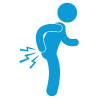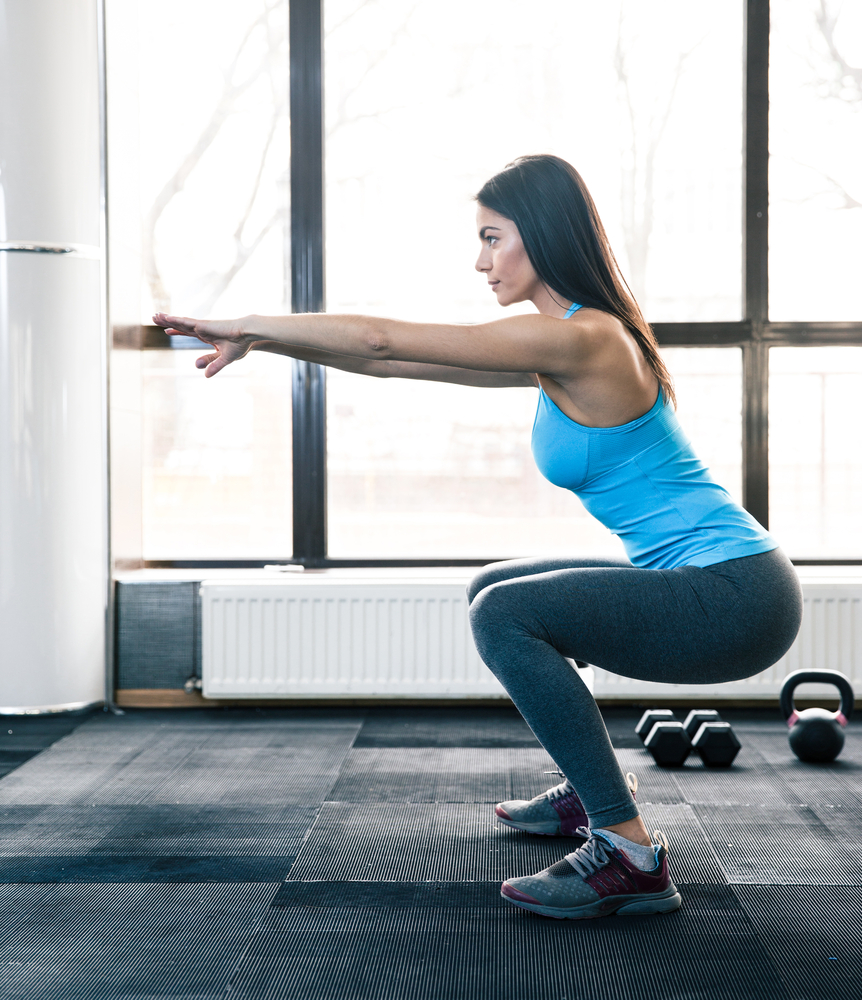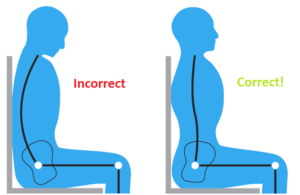Let's start with the basics! Anatomy!
The head of the femur articulates with the acetabulum of the pelvis. Because of the shape of the head of the femur (ball), it has 3 degrees of freedom, or movement directions.
- Flexion/Extension
- Abduction/Adduction
- Internal/External Rotation
These motions are crucial in our everyday function! Especially walking and sitting.

Between the bone surfaces is our labrum (Fun fact, the shoulder has one too!). The labrum is a ring of cartilage that not only cushions the joint but also deepens the congruency of the joint which creates more stability.
Surrounding the joint is the joint capsule. The purpose of the joint capsule is to protect the joint and increase stability. Joint stability is a very important thing. But just like anything, too much of a good thing isn't always a good thing anymore. We will touch on this later but the joint needs to balance stability and mobility otherwise dysfunction begins. Around the joint capsule, are our muscles! Arguably any physical therapist's favorite part of a joint. Our muscles are what activate (because of our nervous system) to move our joint. Rather, they pull on the bones, that cause the joint to move. Movement is important to the joint, not only for out total body function, but also because it flushes the joint with synovial fluid which is nutrition for our joint. Keeps us lubricated and ready for more movement!
What muscles control the hip?
And wow, are there a lot of muscles that make the hip move! Without going into a full list (because that might put you to sleep reading it), some of the heavy hitters are:
- Gluteals: Min, Med and Max
- Piriformis
- Psoas: Minor, major and iliopsoas
- Adductors: brevis, longus, and magnus;
And thats no where near all of them!
The hip joint is complex right? You have probably figured that out at this point. There are all these beautiful layers that help us move, but gives us lots of opportunities for dysfunctions
What kinds of hip dysfunctions are there?
Some of the most common hip ailments are:- Hip Replacements: this can be partial or full. The entire joint surfaces are replaced with plastic, ceramic and/or metal materials. This is done once osteoarthritis has progressed significantly and is impacting the patients ability to be an active participant in their life.
- Avascular Necrosis: interruption of blood flow to the head of the femur.
- Tendonitis: acute inflammation of a tendon caused by injury.
- Femur Fracture: Many reasons for a fracture, but most commonly pathologic, as a result of a fall (especially in the elderly) or major traumatic injury
- Hip Impingement: Occurs when the head of the femur pinches up against the acetabulum secondary to shape and imperfect congruency.
- Piriformis Syndrome: Piriformis muscle becomes tight and impinges upon the sciatic nerve.
- Sciatica: Referred pain into the hip from the spine
- Groin Pain: Nonspecific but often related to tight adductor muscles.
This is not an exhaustive list by any means, but what we see most frequently in the clinic.
What do problems with the hip look like? How do you know if there's something wrong with your hip?
Decreased mobility! It may be hard to get into all your usual positions. Pain! With walking, sitting or even sleeping. Swelling! A puffy look to the front or side of your hip. If you're noticing its difficult to participate in any of your normal activities because of your range of motion or pain then it's time to see a physical therapist!
You have hip pain, now what?
Once you get set up with a physical therapist, they will start with an initial evaluation. Specifically, observing how you move, what your hip joint range of motion looks like, assessing muscle strength and palpating the various soft tissue structures in the area. This will start to paint a picture, in combination with your subjective history about what's going on in your hip! Sometimes it's very obvious, and other times not so much.
The next step is getting you to start feeling better! One of the ways we do this is with manual therapy. Manual therapy helps to calm down irritable tissues, release tension , decrease swelling and generally help those tissues get back to their optimal baseline. Some of the ways we perform these techniques is with massage, trigger point release, joint mobilizations, dry needling and more!
Regardless of hip diagnosis, a common combination of muscle dysfunction we see is tight and tender adductors, rectus femoris and glutes. In addition, tight joint capsules! Treating out these areas can bring your pain level significantly.
What does recovery look like?
Rome wasn't built in a day, and neither is the recovery from your hip injury or dysfunction. We typically want to see our patients 2x per week to build a healing sandwich. One more slice of healing goodness on top of the next. Some patients make huge gains right away, and then hit a plateau. Others take a slower stair step approach and make notable, small gains over time. It's also completely normal to have "flare ups". We hope you don't have them, and do everything possible to limit that but sometimes they do happen. Often because you either progress too fast, or are starting to feel really good and become more active.
Boom vs Bust Cycle??
This "boom" vs "bust" cycle is very common. Boom to mean you are feeling really good and start doing a bunch of activity! But perhaps a 5 mile walk, combined with cleaning your whole house is a bit too much. You may not notice it right away, but later that evening or the next day for sure. The "bust" is that flare up you feel. We should be able to help calm it down and go gently on exercise for a session or two until we get you back to your current baseline.
Ideally this doesn't happen, but we are well equipped to handle it if it does. Additionally, we will develop a personalized program to return to exercise and ADLs to limit the risk of this happening. Despite all our best efforts, you may still have a flare up, but it does not mean you are right back at the beginning!
Once we have started calming down your irritable tissue, the next phase is neuromuscular re-education and strengthening. This can be going on at the same time, they are not exclusive. However, initially your tissues may be too sensitive to do much. But gentle, gradual progression is critical to fully rehabilitating the hip! We want to introduce PNF (Proprioceptive neuromuscular facilitation) early on! Lower extremity PNF patterns are a combination of different motions at the hip, knee, ankle and toes. They have a critical role in our activities of daily living. Our functional activities are a combination of different motions at each joint.
What other kinds of exercises do we do for the hip?
Continue with PNF patterns, squats, bridges, core strengthening, side steps, monster walks, clamshells...the list goes on and on! The possibilities are endless. There is no one exercise that is perfect for every hip and every one. Except for this: walking.
Why Walking?
Walking is one of the most functional activities if not THE most functional activity we all need to do. The hip plays a huge role in ambulation. Immediately after manual therapy, we like to assess the effectiveness of treatment by having you walking around a bit. We can see what has changed during the different phases of gait, what your pain level is, and even if your balance has improved.
We recommend our patients start with a shorter distance/time initially and gradually build. One way to do this is take shorter, frequent walks. For example, if you are looking to walk 30 minutes per day but are only able to tolerate 10 minutes, try to take 3, 10 minute walks throughout the day. Once your endurance has increased, you can take 2, 15 minute walks. And then progress to 30 minutes. Obviously this type of schedule doesn't work for everyone but can be very beneficial.
Motion is so critical to our joint healthiness. Its also a predictor of overall health and wellness. If your hip is hurting its going to affect your ability to access your environment and participate fully in your life. Additionally, at some point you will begin to compensate. The hip is the connection to the hip and low back pain.
Is the low back connected?
The psoas (which we talked about as a hip flexor), actually originates on the anterior part of the spine. If that muscle is tight, it's going to pull you into an anterior pelvic tilt, and increase lumbar lordosis. Lumbar lordosis is increased lumbar extension. Suddenly, your hip dysfunction is now a lumbar dysfunction. This can work in reverse as well. If you've been unsuccessful at managing low back pain, taking a look at anterior hip (specifically psoas) tightness. Where to the muscles that control knee extension originate? The front of the hip! What translates as knee pain, might actually be rectus femoris tightness. Hip and knee pain, as well as knee, hip and lumbar spine pain are all very closely related.
How does the pelvic floor connect to the hip?
.png?width=185&height=185&name=Pelvis%20(3).png) Hip pain and pelvic floor pain and dysfunction are also seen frequently together. If you've noticed deep hip pain that also radiates into your pelvis, and/or pelvic floor dysfunction, obturator internus muscle might be involved. Tight adductor muscles refer up into the pelvis and can mimic pelvic pain, even if the pelvic floor checks out fine. Differential diagnosis for unresolving hip pain, would be to assess the pelvic floor too, even if no obvious dysfunctions. Pregnancy related hip pain is also very common because of the change in ligamentous laxity and widening of the pelvis. Additionally the shift in the center of gravity, and increased pressure on the pelvic floor.
Hip pain and pelvic floor pain and dysfunction are also seen frequently together. If you've noticed deep hip pain that also radiates into your pelvis, and/or pelvic floor dysfunction, obturator internus muscle might be involved. Tight adductor muscles refer up into the pelvis and can mimic pelvic pain, even if the pelvic floor checks out fine. Differential diagnosis for unresolving hip pain, would be to assess the pelvic floor too, even if no obvious dysfunctions. Pregnancy related hip pain is also very common because of the change in ligamentous laxity and widening of the pelvis. Additionally the shift in the center of gravity, and increased pressure on the pelvic floor.
As the old saying goes, our knee bone is connected to our hip bone and the hip bone is connected to the back bone. It's silly and obviously not anywhere near anatomically correct. We can dive even deeper and relate hip dysfunction to foot issues as well. When the foot hits the ground it sends a force all the way up the kinetic chain to the hip and spine. Vice versa how we move our hips during gait affects how we place and position the foot and ankle. Which then comes back up the kinetic chain and the cycle starts all over. A seemingly small issue with foot and ankle range of motion restrictions or weakness can have big consequences to the entire body.
Now what?
If you've been struggling with hip pain, now is a good time to get in and see us! Spring is here, let's get active!
Physical therapy for hip pain in Columbia and Baltimore, Maryland
If you have hip pain reach out to our office today!



